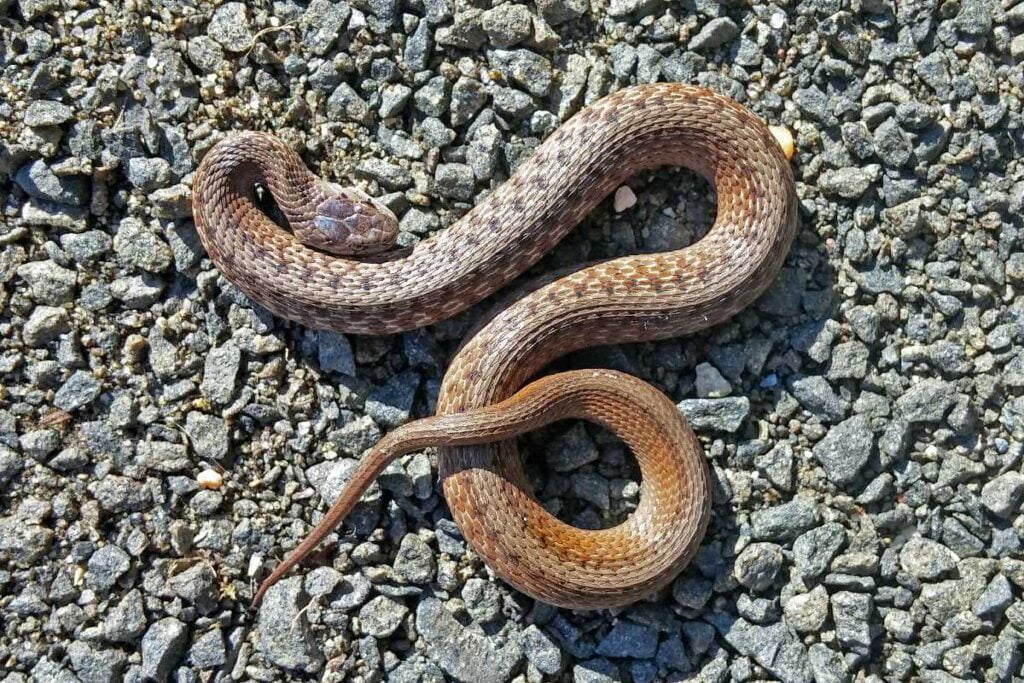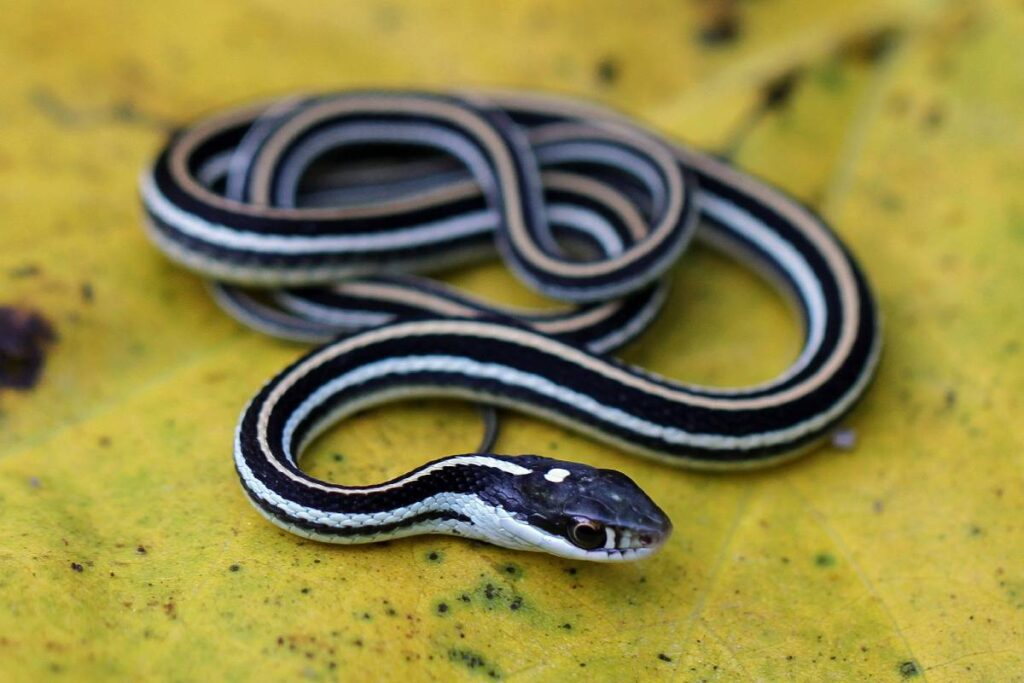8 snake species make Door County their home, and each has its unique characteristics and behaviors. None of them are venemous. This post will help you identify and understand Door County snakes.
Common snakes of Door County include:
- Common Gartersnake
- Common Watersnake
- DeKay’s Brownsnake
- Eastern Foxsnake
- Eastern Ribbonsnake
- Milksnake
- Red-bellied Snake
- Smooth Greensnake
This page contains affiliate links. This means that if you click on the link and make a purchase, we may receive a small commission at no extra cost to you. As an Amazon Associate, I earn from qualifying purchases. This helps us provide content to help you plan life-changing travel experiences. Thanks!

Common Garter Snake

The Common Gartersnake is one of the most widely distributed snakes in North America and can be found in a variety of habitats, including woodlands, wetlands, and fields. These snakes are typically between 18 and 26 inches in length and are characterized by their distinctive stripes, which are usually a yellow or green color. They are non-venomous and feed primarily on small mammals, amphibians, and fish.
Common Water Snake

The Common Watersnake is another common species found in Door County. These snakes are typically between 2 and 4 feet in length and are characterized by their dark coloration and rough scales. They can be found near freshwater sources such as streams, rivers, and ponds, and are known to be excellent swimmers. They are non-venomous and feed primarily on fish and frogs.
DeKay’s Brownsnake

DeKay’s Brownsnake is a small, non-venomous snake that can be found in Door County. These snakes are typically between 10 and 20 inches in length and are characterized by their brown coloration and smooth scales. They are nocturnal and can be found in a variety of habitats, including fields, woodlands, and wetlands. They feed primarily on insects and small rodents.
Eastern Foxsnake (Pinesnake)

The Eastern Foxsnake, also known as a Pinesnake, is a large, non-venomous snake that can be found in Door County. These snakes are typically between 4 and 6 feet in length and have tan or yellow coloration and large, dark blotches. They reside in diverse habitats, including woodlands, fields, and wetlands. They climb well. They feed primarily on small mammals, birds, and other reptiles.

Eastern Ribbonsnake

The Eastern Ribbonsnake is a small, non-venomous snake that can be found in Door County. These snakes are typically between 12 and 24 inches in length and are characterized by their slender build, black and white stripes and smooth scales. They can be found in a variety of habitats, including wetlands and near water sources. They feed primarily on fish and amphibians.

Milksnake

The Milksnake is a non-venomous snake that can be found in Door County. These snakes are typically between 2 and 4 feet in length and are characterized by their red, black and white coloration, and smooth scales. They can be found in a variety of habitats, including woodlands, fields, and rocky outcroppings. They feed primarily on small mammals, birds, and reptiles.
Red-bellied Snake

The Red-bellied Snake is a small, non-venomous snake that can be found in Door County. These snakes are typically between 8 and 10 inches in length and are characterized by their reddish-brown coloration and smooth scales. They can be found in a variety of habitats, including woodlands, fields, and wetlands. They feed primarily on insects and small invertebrates.
Smooth Greensnake

The Smooth Greensnake is a small, non-venomous snake that can be found in Door County. These snakes are typically between 12 and 20 inches in length and are characterized by their bright green coloration and smooth scales. They can be found in a variety of habitats, including woodlands, fields, and wetlands. They feed primarily on insects and small invertebrates.
How to Identify Snakes
You can identify snakes by many qualities, including:
- Size
- Coloration
- Scales and skin type
- Habits
- Habitat
By taking stock of these qualities, and with proper resources, you can make a confident identification of a snake.
One handy resource that can help you identify snakes is a reliable field guide. The “Amphibians & Reptiles of Minnesota, Wisconsin & Michigan: A Field Guide to All 77 Species & Subspecies” is a pretty good one for identifying snakes in Door County, since it only focuses on snake species that are found in the region.
What To Do When You Encounter a Snake in Door County
When encountering a snake in Door County, remember that all native snakes in the area are non-venomous. While the sight of a snake can be startling, remain calm and give the snake a wide berth. Here are a few tips on what to do if you encounter a snake in Door County:
- Keep your distance: Snakes, like all wild animals, can feel threatened and may react aggressively if they feel cornered. Give the snake plenty of space to retreat and avoid getting too close.
- Do not try to handle the snake: Even non-venomous snakes can bite if they feel threatened. Leave handling to professionals.
- Observe from a safe distance: If you’re interested in observing the snake, do so from a safe distance. This will not only protect you but also the snake from stress and potential harm.
- Leave the snake alone: Snakes play an important role in the ecosystem and are beneficial to the environment. They should be left alone to live their natural lives.
- If snake is in a place where it can pose a threat to human or pet safety, contact local wildlife authorities or a professional to help remove it.
It’s also important to remember that snakes can be active throughout the year and that they are often more active at night or during the early morning and evening. By following these simple guidelines, you can safely coexist with the snakes of Door County and appreciate the beauty of these fascinating animals.
Frequently Asked Questions
No, there are no native poisonous snakes in Door County, Wisconsin. Wisconsin has two species of poisonous snakes, but these are found further south in the state.
No, do not kill snakes in Door County. Snakes in Door County are harmless to humans if treated respectfully and if you stay at a distance. Additionally, they are vital contributors to a healthy ecosystem and help to control pests like mice and bugs.
Snakes burrow down into the ground during the winter, often with a group of other snakes, and hibernate.
Conclusion
While the site of a snake might be alarming to you, the snakes of Door County generally pose no great danger. They are a part of the natural beauty of this place.
Summary
- 8 snakes species can be found in Door County
- No snakes native to Door County are venemous.
- Even though no snakes native to Door County are venomous, caution should be exercised around snakes, and they should be treated with respect.
